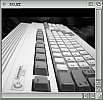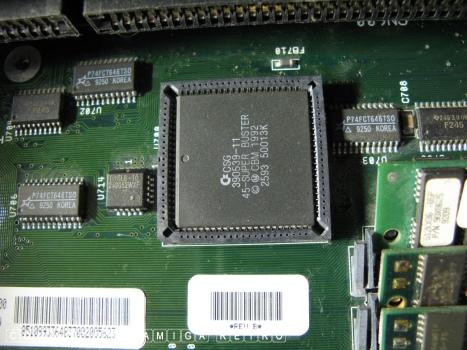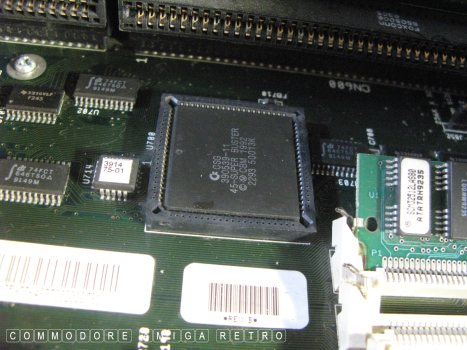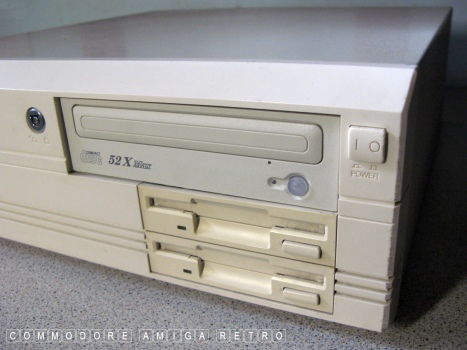
March 29th 2901: scuzzblog: 4000/040 - Breaks my heart.
ScuzzBlog: Diaries January 2024
Entry 2nd January 2024: Post 1: Amiga 4000 - Super Buster 11.
Amiga 4000 - Super Buster 11.
When I first started looking into buying an A4000 I was very
keen to get something that I could use on the internet. I spent
a good while researching a suitable machine and during that time
one issue came up more than any other. The issue of the Buster.
There appeared to be a number of cards that struggled with the
earlier version and the recommended version being the Buster 11
or Super Buster 11.
The issue appears to be the manipulation of multiple DMA channels
on Zorro III cards. A number of cards had been flagged as not
working with the earlier Buster 9 chip. The A4091 being an example
of a card that had problems. The focus being on the SCSI Bus where
the system would lock up when another DMA channel was called upon.
If you do a search on the Amiga Resource site .. Link Here
for expansion cards with Zorro III you will discover a number of
the cards with the line 'only works with Buster 11, either installed
in A3000 or A4000' ... or similar.
Interestingly it was a guy from the Amiga Resource site in Germany
that I purchased my first Amiga 4000d.
To further explain the issue I found this article by Dave Haynie
on the Amiga Big Book site. I am sure he won't mind me quoting
this here.
Suffice to say I always suggest buyers of 4000s try to track down
one with a Super Buster 11 chip, though maybe Zorro III may not
be that important to users these days.
The (Super) Buster - In the words of Dave Haynie.
Though you think it's the same chip, there are actually two Busters:
Level I and Level II. The Level I Buster, up to Rev 7, is used in
all A3000 family machines, and it does NOT support Zorro III bus
masters. Doesn't even try. There came a time in the A3000 development
where I had to chose between adding more Zorro III features (I
designed the whole bus specification before I did the chip work)
and getting Zorro II compatibility up to par. Zorro II was tricky --
in essence, it's a 68000 bus emulator in there, and some of the
interactions between 68K protocol and real Zorro II hardware were
not things you could have easily predicted at the start of the
project. And given that C= management hadn't even asked for
expansion bus improvements on the A3000 (all my idea), you can see
where Level I came from.
The Level II part (about twice as many gates) was out in two
revisions; Rev 9, which initially shipped with the A4000, and Rev
11, which is the best you'll ever get. The Rev 9 part has two bugs
that can cause problems with Zorro III cards. One can affect some
kinds of bus slave cards, it depends on the card design. This is
due to a small flaw in a synchronizer stage in the Level II chip
(Level II runs a slightly faster bus protocol than Level I, and
also supports burst). The other is a flaw in the Zorro III bus
arbiter -- there's a small window in which a Zorro III slave cycle
just starting can confuse a bus registration command, locking the
bus. Rev 11 solves both problems, so you need it for DMA devices.
The Rev 9 problems were fairly well qualified, so you have some
devices that offered work-arounds. I didn't for the A4091 -- at
the time, C= probably wouldn't have let me do the Rev 11 chip if
the A4091 could have worked at all in existing A4000s. A3000s use
the Level I Buster, never intended to work with something like
the A4091. The Rev 11 part works fine in the A3000, and in fact
fixed a race condition between Gary and the chip bus that can
cause memory failures during Zorro II DMA to Chip RAM.
The big problem with Buster testing was the lack of any Zorro III
cards to test it with. Very early on, I did a memory card, which
tested normal slave access and even supported burst, though I
didn't have a Buster that did for a year after this. The next test
board was done for the multiprocessor project. This "Gemini" board
tested the remaining Level II features: bus arbitration, bus mastering,
Quick Interrupts, etc. Unfortunately, I based it on the Buster chip
(there's a secret mode in Buster Level II that lets it run as a card
controller rather than a motherboard controller). But that year (1991),
CSG was changing over from channelled gate arrays to sea-of-gates
technology, and their first chips were running at 1/4 speed or so.
Six months later, I had fast chips, but also the new Engineering
Administration, which considered Gemini either an illegal research
project, or "something from the last administration". So no big
pounding on the Zorro III bus was possible before the A4000 shipped.
In all fairness, the Zorro III project was a large thing to bite
off.
When The PC Industry made EISA, there were hundreds of people
involved: some to hammer out the specs, some to make chips, test,
etc. At Commodore, it was basically just me for most of the life
of Zorro III. The A4091 doesn't work with Level I Buster. Also,
if you have an older A4091, OS2.04 or SuperKickStart could prevent
it from booting, it would require 3.0 or 3.1 ROMs. And, just as a
technical detail, Zorro III doesn't use a clock. The Z3 timing is
based on your motherboard clock, but the bus protocol itself is
asynchronous.
Amiga 4000 - Super Buster 11.
My first A4000 machine
~ March 29th 2021 ~

If you can only see this CONTENT window
then click the image above for the full site
Last updated 2nd January 2024
Chandraise Kingdom
![]()
Keep the Faith
scuzzscink 2024



